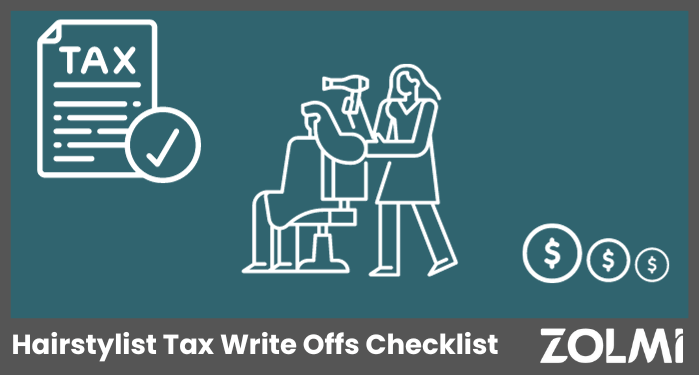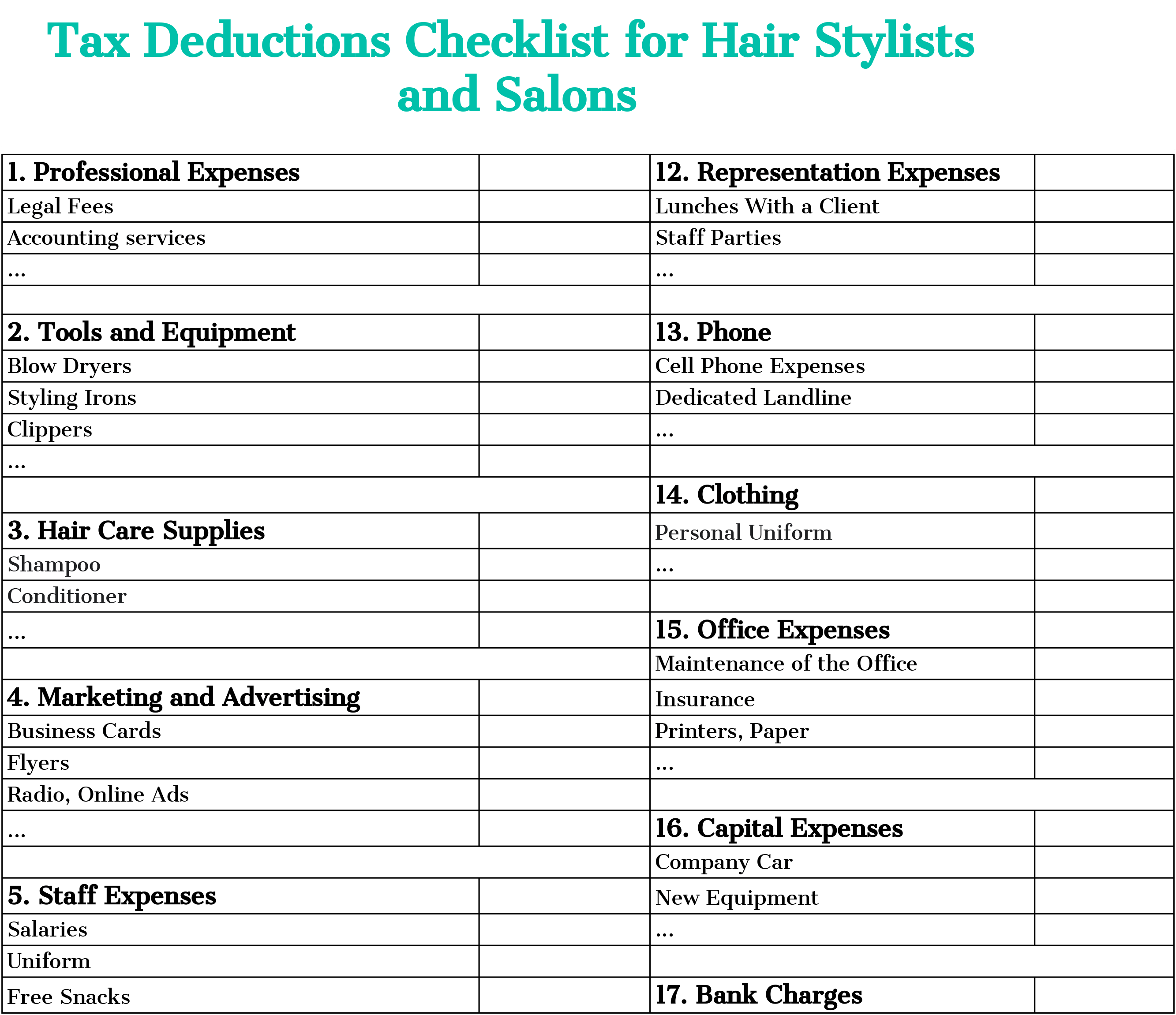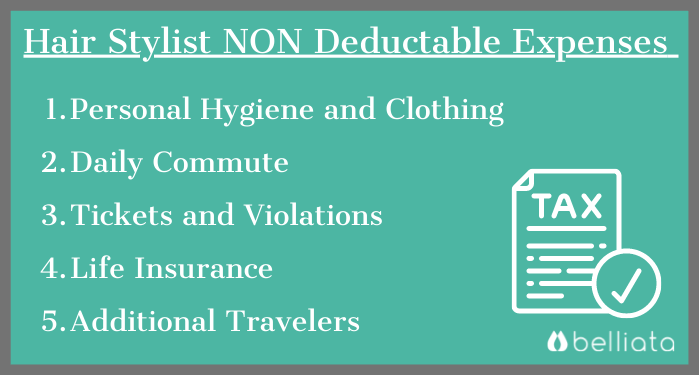Hairstylist Tax Write Offs Checklist for 2024


For a self employed hair stylist, tax write offs can be a game changer. If you track your business expenses and put together a hairstylist tax write off list, you could save hundreds (or maybe thousands) of dollars when filing your taxes.
We’ll look at different costs that you can write off when filing a self employed hairdresser tax return, some common expenses that cannot be deducted and how to prove your income.
What can a hairdresser claim on tax deductions? With tax season coming up, every hairstylist filing taxes will need to know whether or not individual salon expenses are deductible. Self-employed hairstylist taxes have more room to claim specific costs than employees of a company do.
This is where deductions come in. A tax write off for hairstylists allows you to claim different expenses as long as they are both necessary and ordinary- meaning that these things need to help you run your business and be related to or commonly accepted in your line of work.
Some examples of this include tools and supplies, training and licenses (including some types of professional development), mileage and advertising.
Make sure to keep receipts for everything and track them on a hairstylist tax deduction worksheet, because you’ll need to be able to prove these amounts if you want to deduct the cost.
What can a hairstylist write off on taxes? It turns out that there are many things you can potentially use to lower the amount of tax that you’ll ultimately pay.
As professional hair stylists, you’ll want to start by making a list of tax deductible expenses including anything that you have as a recurring cost (such as car mileage) and one-off deductible expense amounts (like equipment or professional clothing).
We’ve put together a list of 21 hairstylist write-offs for taxes, including some examples of when you might use them. Keep this tax deduction checklist ready and maintain a list of what you’ve spent and when, as well as any receipts.
Keep in mind that you should always consult an accountant or tax professional if you’re not certain whether or not you can claim something on your taxes. Here are the most common tax write offs for self employed hairstylist deductions:
Professional Expenses: These common hairstylist tax write-offs include things that you deduct because they’re necessary for running your business, like legal fees or salon accounting services.
Tools and Equipment: You can deduct the cost of any tools or salon equipment that you’ve purchased (items that were given to you by your company probably do not qualify), such as blow dryers, styling irons or clippers.
Hair Care Supplies: Any supplies that you’ve purchased for in-salon use, such as shampoo or conditioner are also deductible. Keep the receipts for these separate from retail inventory costs.
Marketing and Advertising: This is everything related to promoting your hair salon services, including salon business cards, flyers and even radio or online ads.
Staff Expenses: Employee-related expenses may also qualify for deductions, such as benefits plans that you pay into, salaries or even free snacks in the break room. If you provide your stylists with a uniform, you can also claim this as a deductible expense.

Car Mileage and Travel Expenses: Aside from the normal commute from your home to your workplace, you can claim the gas mileage when you’re doing business-related travel. Keep a log of your mileage and gas costs when you travel at all for work, as well as receipts from any repairs that came up while on the road.
You’ll also want to track your meal costs and any hotel stays, such as when you’re attending a convention or training event, for example.
Education and Training: Any continuing education that self employed hair stylists pay for can be deducted. This can include professional development at conferences, hair color classes or any new training that you receive.
Licensing: Both recertifications/renewals and new licenses for hair stylists count towards this. Keep track of your travel expenses and any money that you spend on meals if you leave town for these classes or to renew a license.
Insurance: This includes both individual hair stylist insurance services that cover you at work and health insurance if you don’t receive it through an employer.
Rent, Utilities: If you’re renting either a home office or a salon space, you can deduct the expense of your rent and utilities (if your workspace is at home, you’ll need to calculate this separately- see below).
Salon Software: The money you spend on this salon management software counts toward your tax deductions, since you’re investing in a tool to support your business.
Representation Expenses: Business meals, such as lunches with a client, as well as staff parties where every employee is invited qualify as deductible.
Phone: If you have a cell phone or a dedicated landline that you use for work-related matters, this can be used as a tax deduction.
Clothing: If you wear a personal uniform at your salon, you can deduct the cost of purchasing and maintaining it.
Office Expenses: These can include maintenance of the office itself, insurance or supplies that you use, such as printers, paper, etc.
Capital Expenses: These are different from the fees involved in operating your salon business- capital expenses are the long-term investments that increase your business’s value (such as a company car, or new equipment). They are a tax deduction that you can file over time as they depreciate in value.
Bank Charges: If you have a separate bank account or credit card for your business, then you can deduct the service fees that you pay. This also includes online services for your business, like PayPal.
Home Workspace: The IRS has some pretty specific criteria surrounding this one, so make sure that if you have a home office for your business or a salon workspace connected to your personal home, that you only use it in the course of your job.
You can either calculate this deduction amount by using a simplified formula of $5 per square foot up to a maximum of 300 square feet, or you can keep track of all of your direct expenses (such as supplies, repairs and tools), plus your indirect ones (such as mortgage, utilities, insurance, etc.).
In the case of indirect expenses, you’ll divide them by the percentage of space in your home that’s dedicated to your business.
Energy Saving Improvements: There are tax deduction options available for independent stylists who invest in making their workspace more energy-efficient, either through renovation upgrades or by using renewable energy.
Charitable Deductions: The IRS does have specific criteria on what qualifies as a charitable organization, but as a general rule you’re allowed to deduct the expense of cash donations, as well as certain items such as food, free services or even property.
Miscellaneous: The money that you spend on things like paid parking while you’re working, toll fees or even promotional items that you give out can count towards tax deductions, so make sure to save your receipts.

Personal Hygiene and Clothing: Although maintaining your appearance may be important for a stylist, your personal grooming (such as haircuts, cosmetics, etc.) and any non-uniform clothing are not deductible.
Daily Commute: The regular cost of getting to and from the office or salon is not deductible. This includes a bus pass, drivers’ license, fuel, personal vehicle insurance, etc.
Tickets and Violations: Likewise, any parking fees, speeding tickets or legal violations are not expenses that you can deduct on your taxes.
Life Insurance: If you are the beneficiary of an insurance policy in this case, then it’s non-deductible.
Additional Travelers: Even if you’re travelling for work, expenses related to additional people who aren’t part of the business (such as a spouse or a child) can’t be deducted.
There are three main ways to prove your income. Let’s take a look at each of them:
Bank Statements
If you have a separate account for your salon or styling business, you can use the deposits and your printed statement form to prove monthly and annual amounts coming in.
Remember to keep a salon tax worksheet with expenses listed specifically, so it’s easy to spot these amounts and avoid confusion, later on.
Profit and Loss Statements
This is a summary of your revenue and expenses, so that you can show a lended (or the IRS) your profits and what you’ve spent. Using salon software can help you to easily keep track of your expenditures and organize this data and relevant dates.
Annual Tax Returns
A tax return form is the most straightforward kind of proof in these situations, although it may not account for your full profits if you didn’t include smaller projects or “under the table” amounts that you received.
Don’t forget about tips on your tax returns, either. When filing form 1040 (your individual tax return), keep in mind that you’ll need to account for your tips as part of your overall income.
“So, how do I file taxes as a hairstylist?”
The answer is, with good organization and preparation throughout the year. Tracking your cash flow and expenses using salon software can make this a lot easier.
Make sure to also set appointment reminders for tax accountants well in advance of the deadline to file, so that you’re ready to go. If you do your own taxes online, then make sure to stay on top of your bookkeeping throughout the year to make things go more smoothly.
You have a number of options when it comes to hairstylist tax write offs, so it’s important to save and file your receipts and keep an updated tax deduction checklist ready throughout the year.
Write-offs and profitability in private firms: Disentangling the impact of tax-minimisation incentives
https://www.tandfonline.com/doi/abs/10.1080/09638180.2012.661938
Stock price behavior around announcements of write-offs
https://link.springer.com/article/10.1023/A:1009644800963
Asset write‐offs in the absence of agency problems
https://onlinelibrary.wiley.com/doi/abs/10.1111/j.1468-5957.2008.02078.x